Courtesy of Doug Short.
The Third Estimate for Q2 GDP, to one decimal, came in at 4.6 percent, an upward revision from the Second Estimate of 4.2 percent. The GDP deflator used to calculate real (inflation-adjusted) GDP slipped to 2.1 percent, a downward revision from the Second Estimate of 2.2 percent. Investing.com correctly forecast both numbers.
Here is an excerpt from the Bureau of Economic Analysis news release:
Real gross domestic product — the output of goods and services produced by labor and property located in the United States — increased at an annual rate of 4.6 percent in the second quarter of 2014, according to the “third” estimate released by the Bureau of Economic Analysis. In the first quarter, real GDP decreased 2.1 percent.
The GDP estimate released today is based on more complete source data than were available for the “second” estimate issued last month. In the second estimate, the increase in real GDP was 4.2 percent. With the third estimate for the second quarter, the general picture of economic growth remains the same; increases in nonresidential fixed investment and in exports were larger than previously estimated (for more information, see “Revisions” on page 3).
The increase in real GDP in the second quarter primarily reflected positive contributions from personal consumption expenditures (PCE), exports, private inventory investment, nonresidential fixed investment, state and local government spending, and residential fixed investment. Imports, which are a subtraction in the calculation of GDP, increased.
Real GDP increased 4.6 percent in the second quarter, after decreasing 2.1 percent in the first. This upturn in the percent change in real GDP primarily reflected upturns in exports and in private inventory investment, accelerations in nonresidential fixed investment and in PCE, and upturns in state and local government spending and in residential fixed investment that were partly offset by an acceleration in imports. [Full Release]
Here is a look at GDP since Q2 1947 together with the real (inflation-adjusted) S&P Composite. The start date is when the BEA began reporting GDP on a quarterly basis. Prior to 1947, GDP was reported annually. To be more precise, what the lower half of the chart shows is the percent change from the preceding period in Real (inflation-adjusted) Gross Domestic Product. I’ve also included recessions, which are determined by the National Bureau of Economic Research (NBER).
Here is a close-up of GDP alone with a line to illustrate the 3.3 average (arithmetic mean) for the quarterly series since the 1947. I’ve also plotted the 10-year moving average, currently at 1.6 percent, down from 1.7 percent last quarter.
Here is the same chart with a linear regression that illustrates the gradual decline in GDP over this timeframe.
A particularly telling representation of slowing growth in the US economy is the year-over-year rate of change.
And for a bit of political trivia, here is a look at GDP by party in control of the White House and Congress.
In summary, the Q2 GDP Third Estimate of 4.6 percent matched the forecast of most mainstream economists and reinforces the opinion that the Q1 GDP contraction was a weather-related fluke.








